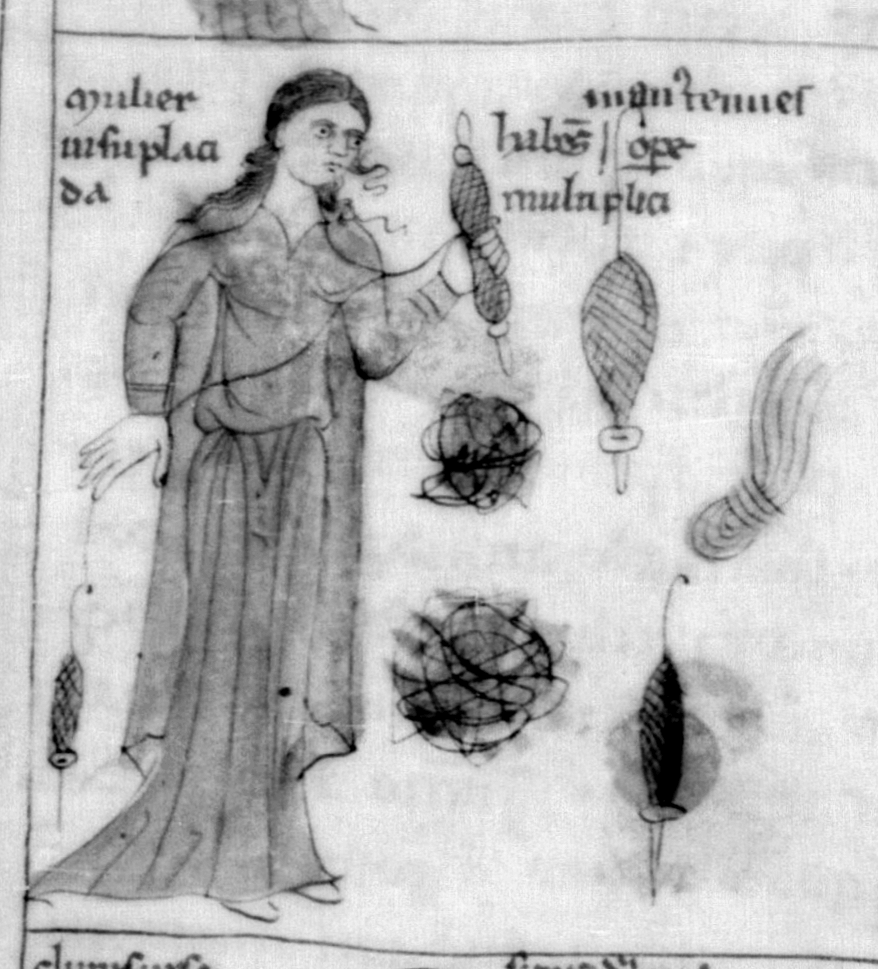I dug out two spindles, one quite full and one with just a little yarn on it, and a third empty one, and gave it a go.
Here's the picture again:
[caption id="attachment_5309" align="alignnone" width="411"]
 Bibliothèque Nationale de la France, Manuscript Latin 7330, liber astrologiae Georgii Zapari Zothori Fenduli, c 1301-1400. Fol. 30r, if I’ve interpreted things correctly. Permalink to the page in the digital BNF.
Bibliothèque Nationale de la France, Manuscript Latin 7330, liber astrologiae Georgii Zapari Zothori Fenduli, c 1301-1400. Fol. 30r, if I’ve interpreted things correctly. Permalink to the page in the digital BNF.Because the picture looked a bit like there might be one strand of yarn running around her neck, and the other straight, I tried that first, thinking it might be easier that way to control tension. Well. It didn't work at all for me; it was hard to impossible to control the two spindles and winding off the yarn from them.
Consequently, I tried it straight from the two spindles - and oh, yes, that is much easier for me. Rolling off yarn from the two spindles in the left hand went surprisingly well and evenly, even though there was much less on one of the spindles. What I did was pull a length of yarn out with the right hand, then set the spindle into motion, moving my right hand up and down the length of doubled yarn while the spindle turned, to let the twist distribute evenly. Once enough twist was in the two plies, I wound the finished bit onto the spindle, then repeated by winding (pulling) the next length.
I'm not the Queen of Plying, and it's neither a job I particularly like, nor one I'm very good at, no matter the tool and method. This way to ply, though, felt like it could offer more control that I've had with other methods, not least because it is possible to control both spindles in the left hand individually. Opening or closing the fingers in question some more can fine-tune the tension on one of the yarns, and it's even possible to give one of them some extra turning motion to even out things, or to help when yarn gets "stuck" unwinding, as it sometimes does.
So... back to the picture. While most of the commenters and me suspected that there might be one thread running behind her back, Satekai very rightly observed the woman's also wearing a cloak (which is magically staying in place, but never mind that for the moment), and the "yarn" going across her shoulder might just as well be the outline of her cloak on the shoulder. Which is an interpretation that I'd now totally second, after a) my try and b) judging from two other comments: Joy Wandrey saying she has had good success, and was able to control tension quite well plying off two spindles (I assume that was direct as well, as there's no mention of anything being led around anything else) and Jane's comment about having problems when plying off two spindles, one held in front and one behind.
This is definitely something that I'll try again. It would be wonderful to have a quick, easy, and reliable plying method, and one that is documented for the Middle Ages to boot!